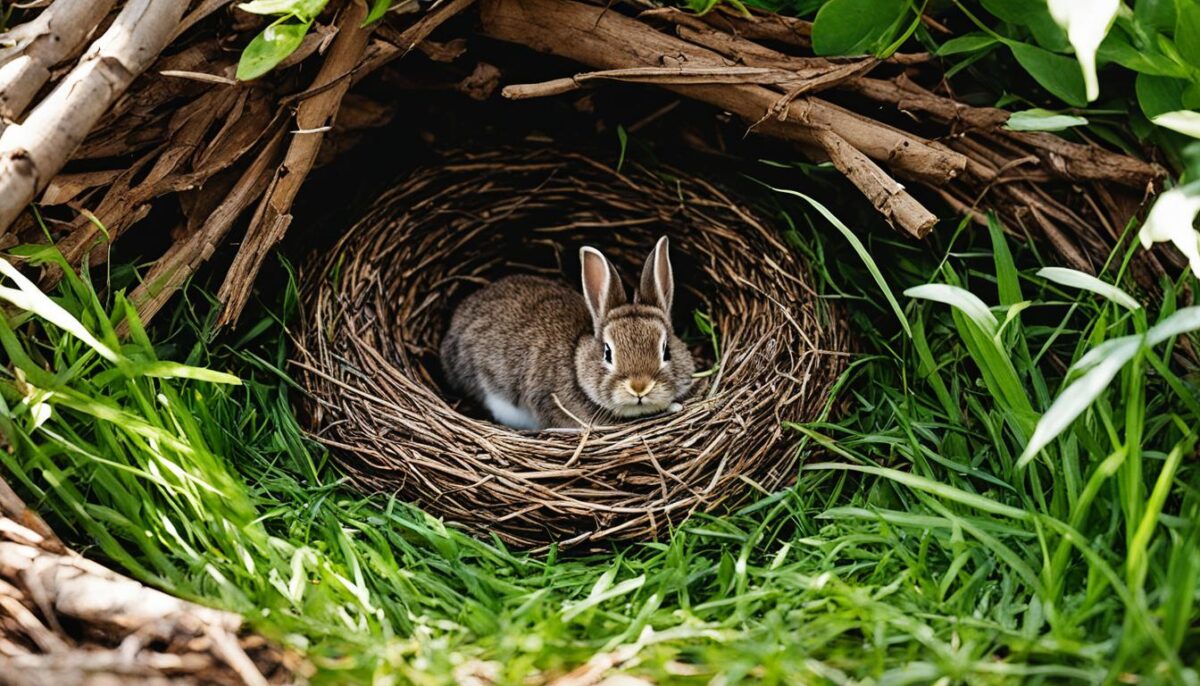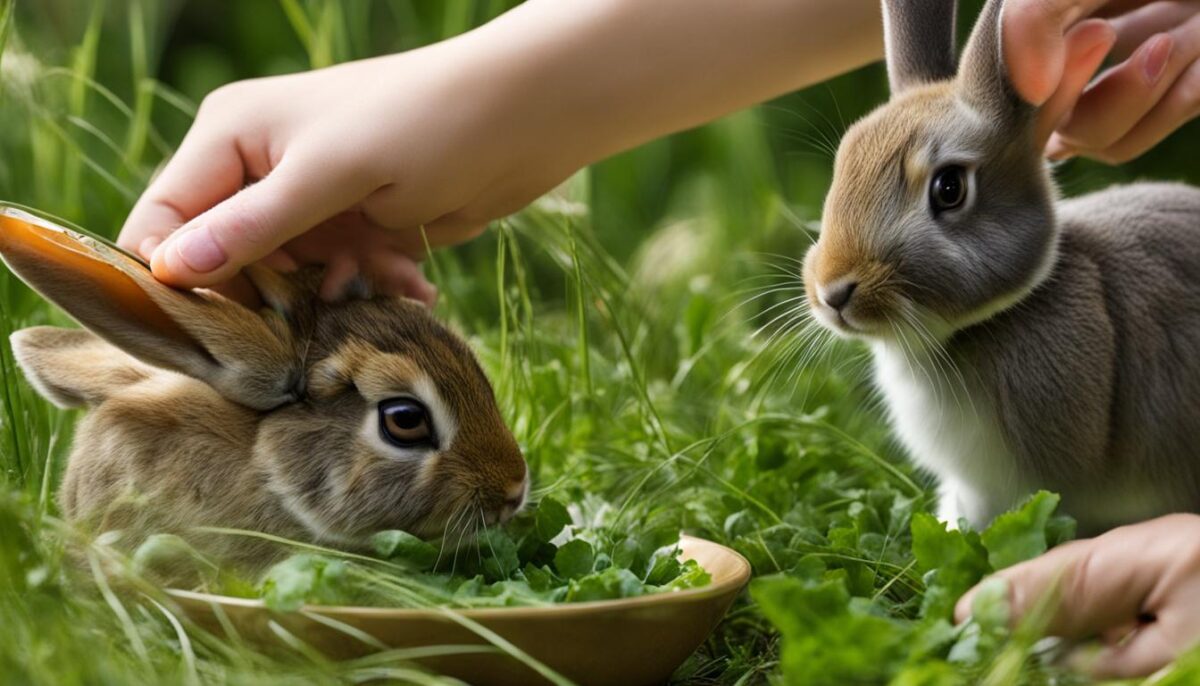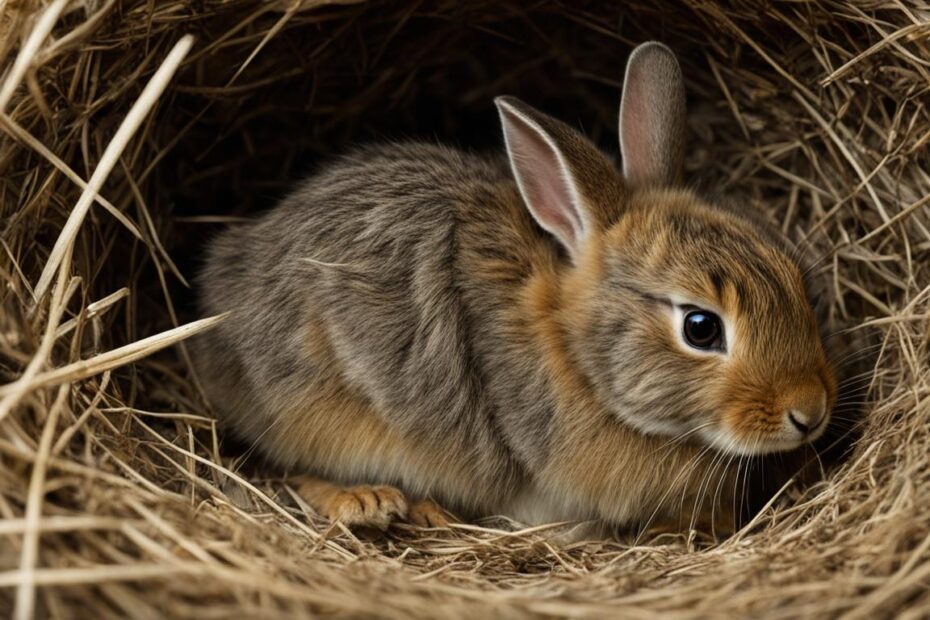If you’ve come across a 3 week old wild rabbit that requires care, it’s important to provide the proper nurturing to ensure its growth and development. This section will cover essential tips for caring for a 3 week old wild rabbit, including their diet, habitat, and safe handling.
Key Takeaways:
- Understand the life stages and development milestones of a wild rabbit
- Provide a safe nest and warm environment for the baby rabbit
- Follow an appropriate feeding schedule and gradually introduce solid foods
- Offer a variety of rabbit-friendly foods and ensure access to clean water
- Transition the rabbit to its natural habitat gradually
Creating a Safe Nest for the Baby Rabbit
When caring for a 3 week old wild rabbit, it’s crucial to provide a safe and comfortable nest for them to rest in. This can be done by using a wooden or plastic box lined with hay for insulation.
The nest should be placed in a warm area, ideally with a heating pad or heat lamp to maintain a temperature of 100°F for the first 2 weeks. It’s also important to handle the baby rabbit with care and ensure they have a barrier, such as a screen, to protect them from potential dangers.

| Materials required for creating a safe nest: | Instructions: |
|---|---|
| Wooden or plastic box | 1. Choose a suitable box size that allows enough space for the baby rabbit to move comfortably. |
| Hay or straw | 2. Line the bottom of the box with a thick layer of hay or straw for insulation and added comfort. |
| Heating pad or heat lamp | 3. Place a heating pad or heat lamp in the vicinity of the nest to maintain a constant temperature of 100°F. |
| Screen or barrier | 4. Install a screen or barrier around the nest to protect the baby rabbit from potential dangers while allowing proper ventilation. |
Feeding the Baby Rabbit
Feeding a 3 week old rabbit requires special attention to ensure their proper nutrition and growth. During this stage, their diet mainly consists of baby rabbit formula, which should be provided until they reach 6 weeks old. It’s crucial to follow a feeding schedule based on the rabbit’s age and size to ensure they receive adequate nourishment.
Introducing solid foods to a baby rabbit should be done gradually. Around 4 to 5 weeks old, you can start offering small amounts of fresh grass and hay. This helps them develop their digestive system and prepares them for weaning. Remember to introduce new foods one at a time and monitor the rabbit’s response to identify any potential allergies or digestive issues.
At around 6 weeks old, when the rabbit is ready for weaning, you can start introducing more solid foods such as vegetables and fruits. This transition should be done slowly, adding small portions of rabbit-friendly vegetables like carrots, spinach, and broccoli. Fruits like apples or bananas can be offered as occasional treats.
To help you ensure the baby rabbit’s nutritional needs are met, here is a sample feeding schedule:
| Age | Feeding Schedule |
|---|---|
| 3-4 weeks | Formula every 4 hours |
| 4-5 weeks | Formula every 5-6 hours |
| 5-6 weeks | Formula every 6-7 hours; introduce small amounts of grass/hay |
| 6 weeks | Weaning process; offer formula every 8 hours, along with veggies and fruits |
Weaning a baby rabbit typically concludes when they are 6 weeks old and are confidently consuming solid foods. At this point, they can be released back into the wild, if deemed appropriate and their health permits.

To prepare a wild rabbit for release, start by gradually decreasing the amount of formula they receive and introducing them to fresh greens and vegetables. This helps their digestive system adapt to a new diet and encourages them to forage for food on their own.
Moving a Rabbit Outside
Once the baby rabbit reaches around 6 weeks old, it’s time to move their enclosure outside. It’s important to choose a suitable location that mimics their natural habitat as much as possible. This includes providing plenty of grass, hiding places, and a water source.
When moving the rabbit outside, transfer them to a wired hutch that allows them to feel the breeze and hear the sounds of nature. The hutch should have enough space for them to move around comfortably and engage in natural behaviors, such as hopping and exploring.
Ensure the rabbit’s new outdoor enclosure is secure and protected from predators. A roof or cover can prevent larger animals from causing harm, while a sturdy fence can keep out predators.
Releasing a Rabbit into the Wild
The timing of the release is crucial to the rabbit’s survival. Wait until the baby rabbit is around 6 to 8 weeks old and fully grown before releasing them into the wild. This ensures they have the strength, size, and skills necessary for survival.
Select a release location that provides ample food sources, such as grass and vegetation, as well as hiding places and shelter. Gradually open the enclosure and allow the rabbit to explore and acclimate to their surroundings.
“Releasing a rabbit into the wild is a rewarding experience and the ultimate goal of their rehabilitation. However, it’s important to remember that intervention should only occur when absolutely necessary. Wild rabbits have the best chance of survival when left in their natural environments.”
Summary
Moving a baby rabbit outside and eventually releasing them into the wild requires careful preparation and consideration. By gradually transitioning the rabbit, providing a suitable outdoor enclosure, and choosing the right release location, you give them the best chance for a successful return to their natural habitat.
| Steps for Transitioning a Rabbit to the Wild | Description |
|---|---|
| Weaning Off Formula | Gradually reduce formula and introduce solid foods. |
| Moving Outside | Transfer the rabbit to a wired hutch in an outdoor location. |
| Choosing a Release Location | Select a suitable environment with food sources and shelter. |
| Releasing Into the Wild | Open the enclosure and allow the rabbit to explore their new habitat. |
Common Myths and Misconceptions
When it comes to caring for baby rabbits, there are several myths and misconceptions that can lead to improper care and potential harm to these delicate creatures. In this section, we will debunk common myths about baby rabbits and provide accurate information to ensure the proper care and well-being of these adorable animals.
Myth #1: Baby rabbits can be fed cow’s milk or human baby formula.
The truth is, baby rabbits have specific dietary needs that cannot be met by cow’s milk or human baby formula. Feeding them these substances can cause digestive issues and even be fatal. Baby rabbits require a specialized formula that provides the necessary nutrients for their growth and development.
Myth #2: Baby rabbits can survive on their own in the wild.
Contrary to popular belief, baby rabbits are not able to survive on their own in the wild. They require proper care and nurturing until they are old enough to fend for themselves. Attempting to release a baby rabbit too early can significantly decrease their chances of survival.
Myth #3: Baby rabbits should be bathed regularly.
Bathing baby rabbits is not necessary and can actually be harmful to them. Rabbits are meticulous groomers and can keep themselves clean. Excessive bathing can cause stress, disrupt their natural oils, and lead to health issues. It’s best to leave bathing to the rabbits themselves.
By debunking these myths and providing accurate information, we can ensure the proper care and well-being of baby rabbits. It’s important to rely on factual knowledge and follow the best practices for caring for these adorable creatures.
Debunking Myths and Providing Accurate Information
| Myth | Debunked |
|---|---|
| Baby rabbits can survive on cow’s milk or human baby formula. | Feeding baby rabbits cow’s milk or human baby formula is harmful and can lead to health issues and even death. Baby rabbits require a specialized formula for their specific dietary needs. |
| Baby rabbits can be released into the wild at a young age. | Baby rabbits are not capable of surviving on their own in the wild and require proper care and nurturing until they are old enough to be released. |
| Baby rabbits should be bathed regularly. | Bathing baby rabbits is unnecessary and can be stressful and harmful to them. Rabbits are capable of grooming themselves and should be left to do so. |
It’s important to remember that myths and misconceptions can lead to improper care and potential harm to baby rabbits. By debunking these myths and providing accurate information, we can ensure the health and well-being of these adorable creatures.
Conclusion
Caring for a 3 week old wild rabbit requires attention to detail and proper nurturing. By providing a safe nest, feeding them a proper diet, and gradually transitioning them to the wild, you can ensure the healthy growth and development of the rabbit.
Creating a safe and comfortable nest is essential for the well-being of the baby rabbit. Use a wooden or plastic box lined with hay, and keep it in a warm area with a heating pad or heat lamp to maintain a temperature of 100°F for the first 2 weeks.
Feeding the baby rabbit a proper diet is crucial for their nutrition. Start with formula for the first 6 weeks, then gradually introduce solid foods like grass, vegetables, and fruits. Follow a feeding schedule based on their age and size, and ensure they have access to clean water at all times.
When the baby rabbit is around 6 weeks old, it’s time to transition them to their natural habitat. Move their enclosure outside, provide a wired hutch and a grazing area, and release them into the wild when they are 6 to 8 weeks old and fully grown.
By dispelling myths and misconceptions about caring for baby rabbits and relying on factual information, you can provide the best care possible for a 3 week old wild rabbit. With your dedication and proper care, these adorable creatures can thrive and return to their natural habitat, contributing to the balance of the ecosystem.
FAQ
How old is a 3-week-old wild rabbit?
A 3-week-old wild rabbit is approximately 21 days old.
What should I use to create a safe nest for a 3-week-old wild rabbit?
You can use a wooden or plastic box lined with hay to create a safe nest for a 3-week-old wild rabbit.
How should I keep a 3-week-old wild rabbit warm?
You can maintain a temperature of 100°F in the nest by using a heating pad or heat lamp for the first 2 weeks.
What should I feed a 3-week-old wild rabbit?
A 3-week-old wild rabbit should be fed formula for the first 6 weeks of its life.
When can I introduce solid foods to a 3-week-old wild rabbit?
Solid foods such as grass, vegetables, and fruits can be gradually introduced after 6 weeks of age.
How often should I feed a 3-week-old wild rabbit?
It’s important to follow a feeding schedule based on the baby rabbit’s age and size. Consult a wildlife rehabilitator for specific guidance.
What should I feed a 3-week-old wild rabbit aside from formula?
As the baby rabbit grows, you can introduce a diet consisting of grasses, fruits, vegetables, and hay.
How and when should I wean a 3-week-old wild rabbit?
Weaning typically takes place around 6 weeks of age when the rabbit is capable of eating whole foods. Consult a wildlife rehabilitator for specific guidance.
When can I release a 3-week-old wild rabbit into the wild?
The rabbit can be released when it is 6 to 8 weeks old and fully grown. Select a suitable location with proper habitat elements.
What are some common myths about caring for baby rabbits?
There are many myths and misconceptions surrounding baby rabbit care. It’s important to dispel these myths and rely on factual information for proper care.


